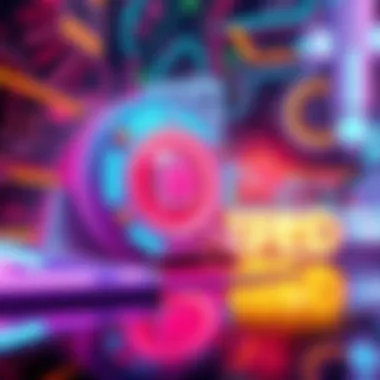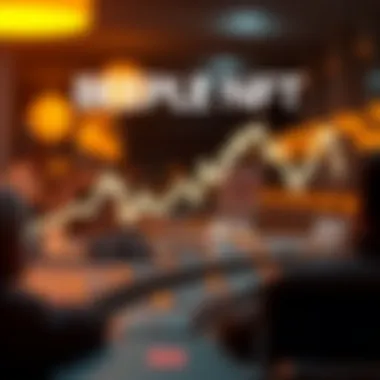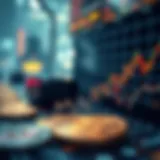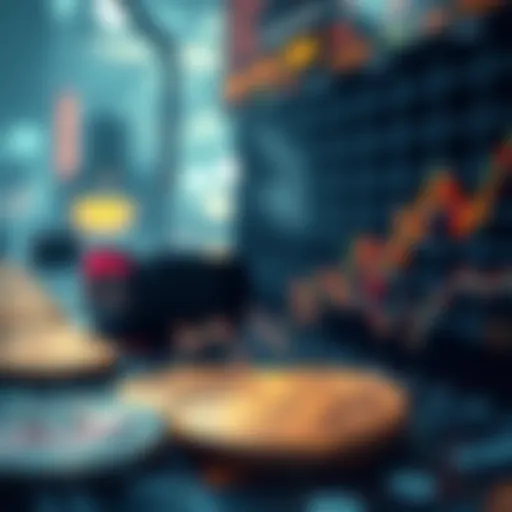Exploring Beeple NFTs: A Comprehensive Overview


Intro
As the world of digital art continues to expand, the significance of non-fungible tokens (NFTs) becomes increasingly apparent. Among the pioneers in this space is Beeple, a digital artist who has captured attention for his innovative approach and sheer volume of work. This article will unravel the intricate dynamics of Beeple's NFT collection, focusing on its market trends, characteristics, and implications for ownership in the digital age.
In understanding Beeple's impact, one must appreciate not just the artworks themselves but the cultural and technological shifts they represent. Owning a piece of Beeple’s portfolio doesn't merely mean acquiring art; it signifies a stake in a burgeoning movement that aims to redefine ownership and creativity within the digital realm. The bold colors and surreal concepts that characterize Beeple’s pieces are reflective of a larger dialogue happening within the world of art, technology, and finance.
Viewers and investors are drawn to his work for a variety of reasons, from aesthetic enjoyment to the notion of investment in modern assets. But like that old saying goes, one mustn't put all their eggs in one basket. As the landscape of NFTs evolves, it presents both opportunities and challenges for those wishing to partake in this new frontier.
Let’s dive into the nitty-gritty of crypto insights, where we’ll chat about market trends and the ups and downs of prices in this evolving marketplace.
Crypto Insights
Understanding Market Trends
Beeple's NFTs stand at a notable intersection of art and finance. To grasp how these tokens are performing within the market, one should look at the trends dictating demand. After all, every movement in the cryptocurrency market reflects a larger narrative about what's valued in today's society.
Recent months have shown that enthusiasm for NFTs can be volatile. Market interest tends to ebb and flow, with certain artworks generating significant buzz while others remain less recognized. For instance, when Beeple sold "Everydays: The First 5000 Days" at Christie's for a staggering $69 million, it lightning-bolted the conversation around digital ownership, positioning Beeple as a leading figure in this field. Investors and collectors began to pay close attention to not just the price tag but also the narrative and cultural impact that each piece of art holds.
To keep pace, collectors should note several key factors:
- Mass Media Attention: High-profile sales ignite interest and encourage new investors to explore NFTs, which can lead to increased demand and price surges.
- Cultural Events: Collaborations with music events or gaming can influence NFT value, tapping into different audience bases.
- Market Speculation: Like cryptocurrencies, NFT values can skyrocket or dwindle based on market speculation and investor behavior.
Analyzing Price Fluctuations
Price fluctuations in the NFT market are far from random; they are often tied to a complex web of factors that require close monitoring. Understanding why certain Beeple pieces may rise or fall in value may also hinge on:
- Rarity and Uniqueness: The scarcity of a particular NFT often drives its value. If a piece comes from a limited collection, collectors might find themselves more willing to invest heavily.
- Historical Context: Beeple’s work reflects cultural sentiments or commentary on current events, which can resonate with collectors on a personal or societal level, enhancing desirability.
- Following the Artist: The strength of Beeple’s personal brand plays a compounding role. A strong following across social media and platforms can buoy prices as more people wish to own a piece from a recognized figure.
Do keep in mind that while opportunities are abundant, the NFT realm can be a double-edged sword requiring due diligence. The volatility of prices can be daunting, but with careful analysis and an understanding of the underlying forces at play, investors can navigate these waters with more astuteness.
"The emerging nature of NFTs demands a fresh approach to valuation, where the narrative and cultural relevance become as crucial as the technology itself."
The Rise of Beeple
Understanding the ascent of Beeple within the digital landscape is essential for contextualizing his influence on the art world and the NFT market. This section highlights not only the artist's journey but also the broader implications of his work, especially as they pertain to democratization in art ownership and valuation. In a realm where traditional art institutions have long held the reins, Beeple’s emergence marks a shift, stirring conversations about accessibility, creativity, and digital rights.
Background of the Artist
Beeple, born Mike Winkelmann, is not your run-of-the-mill artist. He started as a graphic designer, honing his skills while working on diverse projects across different media. His early work is heavily influenced by pop culture, combining elements from video games, movies, and various societal reflections, often with a satirical twist. This eclectic mix laid a rich foundation for his later digital creations.
A pivotal shift occurred when Beeple began his project "Everydays," where he committed to creating a new piece of digital art every single day. This practice not only showcased his relentless creativity but also led to a visually stunning archive that exemplified his artistic evolution.
Largely self-taught, Beeple's blend of advanced digital techniques with storytelling created immersive works that resonate deeply with viewers. His ability to engage with contemporary issues through his art—ranging from climate change to political commentary—elevated his status from a simple digital artist to a disruptive force in the art world. As his following grew, so too did the interest in his unique NFT creations, setting the stage for his monumental entry into that new art frontier.
Transition to NFTs
The transition to NFTs for Beeple was nothing short of revolutionary. In the early days, NFTs appeared to be a niche market, largely for crypto enthusiasts. However, Beeple saw the potential to transcend boundaries with his art in this new medium. When his first significant NFT was launched, it was evident that this was not mere experimentation; instead, it was a calculated step toward redefining art ownership.
By minting his work on the Ethereum blockchain, Beeple embraced a mechanism that offered both proof of authenticity and traceable ownership. The implications were staggering: for the first time, digital art could carry the same weight as traditional art, where provenance and ownership play a crucial role in value. His transition epitomized a broader movement within the artistic community, where digital creations were now validated beyond the confines of the physical world.
This change resonated with many artists and collectors, prompting an influx of interest in NFTs. Think about it: where one previously needed a physical space or gallery to showcase talent, in the NFT realm a single digital asset can reach global audiences in an instant.
In summary, the rise of Beeple is not just a narrative about a singular artist but rather a lens through which one can appreciate the shifting dynamics of art as we know it. His unique journey, from grassroots beginnings to NFT pioneer, is a captivating testament to the evolving definitions of creativity and ownership in the digital age.
Understanding NFTs
The concept of non-fungible tokens or NFTs is pivotal in grasping the landscape of digital art, especially concerning Beeple's contributions. As we journey through the intricacies of Beeple's art, it’s crucial to dissect what NFTs are and how they uniquely function within the broader spectrum of digital ownership. This understanding enhances our perception of Beeple's works and their place in a rapidly evolving market.
What Are Non-Fungible Tokens?
Non-fungible tokens (NFTs) are distinct digital assets that represent ownership of a specific item or piece of content on a blockchain, making them irreplaceable. Unlike regular cryptocurrencies such as Bitcoin or Ethereum, which are fungible and can be exchanged on a one-to-one basis, NFTs have unique information or attributes that set them apart from one another.
To illustrate:
- A five-dollar bill can be exchanged for another five-dollar bill without any change in value or utility. They are identical.
- In contrast, an NFT tied to a digital artwork possesses exclusive ownership rights that cannot simply be swapped for another NFT because each token has its unique value and significance.
NFTs are built on blockchain technology, which ensures transparency, security, and provenance. When you purchase an NFT, a record of that transaction is securely stored on the blockchain, making it verifiable and tamper-proof. This is particularly valuable for artists like Beeple, as it provides authenticity to their digital works, which can often be replicated but never overtly owned.
Some key characteristics of NFTs include:
- Uniqueness: Each NFT has distinct information that makes it one-of-a-kind.
- Indivisibility: Unlike cryptocurrencies, NFTs cannot be broken down into smaller denominations; they exist solely as whole tokens.
- Interoperability: NFTs can be utilized within different platforms and marketplaces, increasing their value and accessibility.


For more information, you might want to check those resources: Wikipedia and Britannica.
How NFTs Differ from Cryptocurrencies
While both NFTs and cryptocurrencies are built on blockchain technology, they serve very different purposes and offer different types of value. Understanding these differences is essential, particularly when discussing the impact of Beeple's NFTs in the contemporary art scene.
- Purpose:
- Value Determination:
- Market Behavior:
- Cryptocurrencies are designed as a medium of exchange or store of value, functioning similar to traditional currencies but in a digital form.
- NFTs, on the other hand, are used primarily to prove ownership and authenticity of digital assets, such as artwork, music, or virtual real estate.
- Cryptocurrencies typically derive their value from market perception, supply, and demand dynamics.
- The value of an NFT is more subjective, often dependent on the artist's reputation, the cultural relevance, and the emotional connection potential buyers have with the piece.
- The cryptocurrency market is often volatile, driven by speculation and trading.
- In contrast, the NFT marketplace can reflect trends, artist merit, and community interest more prominently.
"Understanding NFTs is foundational to navigating their unique market positions and appreciating the works of artists like Beeple in a modern context."
As the NFT landscape continues to expand, comprehending the nuances between NFTs and traditional cryptocurrencies will be crucial for anyone invested in this space, be it for artistic, financial, or technological reasons. In a world increasingly oriented towards digital ownership, knowing these distinctions can lead to more informed decisions regarding purchases and collections.
The Genesis of Beeple NFTs
The emergence of Beeple NFTs marks a pivotal moment in the landscape of digital art and collectibles. Not only do these tokens represent a new era for artists but they also disrupt traditional notions of ownership and valuation in the art world. Understanding the genesis of Beeple's NFT journey helps shed light on the artist's unique position within the booming NFT marketplace and the intricate web of influences that shaped his work.
Early Works and Influences
Beeple, whose real name is Mike Winklemann, began his artistic journey long before he became a household name in the NFT realm. His early work was heavily influenced by the culture of the digital age. Growing up in the early internet era, Beeple was immersed in a world that embraced graphic design, animation, and technology. Early on, he started to experiment with different media, which paved the way for the striking visuals that his audience has come to know.
His renowned daily project, in which he created a unique piece of digital art every day for over a decade, showcases not just his dedication but also an evolution of style. This daily discipline nurtured a fertile ground for creativity, leading to pieces that are often layered with commentary on contemporary culture, politics, and technology. The visual style he developed during this time is a blend of 3D art techniques, vibrant colors, and surreal storytelling, allowing viewers to find familiarity in the bizarre.
"Every day I try to push the limits of what I can create, and working with new technology like NFTs has allowed me to engage with my work in uncharted ways."
— Beeple
Milestone Moments in Beeple's Career
Several milestones define Beeple's career and invariably connect to the evolution of his NFTs. A significant pivot occurred in 2020 when societal shifts caused by the pandemic prompted people to seek new forms of expression and connection. This environment wasn't just ripe for artists but also for the burgeoning NFT market. Beeple's trajectory took an exponential leap when he auctioned off his work "Everydays: The First 5000 Days" at Christie's in March 2021, selling for a staggering $69 million. This event wasn't merely a sale; it was a statement that digital art had arrived as a legitimate form of investment.
Following this, Beeple became an icon, inspiring countless emerging artists to explore NFTs as a viable medium for selling their work. His approach to engaging with his audience through social media and other platforms has encouraged a layer of transparency rarely seen in traditional art. His collaborations, ranging from music to virtual reality, further showcase the profound impact he has had, setting the stage for what some term as the ‘Beeple Effect’ in the art world.
The genesis of Beeple NFTs is more than just a collection of digital tokens; it is a case study in the transformation of art and the potential future of creative ownership. By tracing Beeple's influences and monumental career moments, one can appreciate not only his role in shaping the NFT landscape but also the broader implications for artists navigating this innovative space.
Market Dynamics of Beeple NFTs
The world of non-fungible tokens, particularly those created by Beeple, holds a unique position in the digital art ecosystem. Understanding the market dynamics surrounding these NFTs is essential for anyone interested in digital assets, whether they are seasoned investors or curious newcomers. This section aims to unpack the various components that define the current landscape of Beeple NFTs, centering on their valuations, sales figures, and the trading trends contributing to their perceived value.
Current Valuations and Sales Figures
Valuations in the NFT space can fluctuate like the weather, often influenced by market sentiment and trends. Beeple’s creations, however, have set a standard that is hard to ignore. Take, for instance, his piece "Everydays: The First 5000 Days," which fetched a staggering $69 million at auction. Such outcomes have reshaped how digital art is perceived and marketed.
Recent sales figures show an upward trajectory for Beeple NFTs. New pieces consistently enter the market, with collectors and investors eager to grab a piece of art that not only exists in the digital realm but also adds historical significance. Interestingly, the average sale price of Beeple's NFTs has shown resilience even amidst broader market downturns, illustrating a kind of intrinsic value that keeps buyers interested.
Here are key points related to current valuations and sales figures:
- High-profile auctions: Many of Beeple's works have been auctioned at significant platforms, creating buzz.
- Dynamic price range: There exists a wide price range for Beeple NFTs, catering to both high-end collectors and more casual buyers.
- Collector enthusiasm: The desirability of owning a Beeple piece continues to attract attention from various sectors, from tech-savvy Millennials to traditional art collectors.
Trends in NFT Trading
As the NFT marketplace continues to mature, several trends have emerged that influence how Beeple's NFTs are bought and sold. The first notable trend is the growing acceptance of digital assets by mainstream institutions. Major auction houses like Christie's have ventured into this domain, indicating a shift towards recognizing digital art as a legitimate form.
Moreover, social media plays a pivotal role in the dissemination and promotion of Beeple's work. Platforms like Twitter and Instagram have given rise to a community fervently discussing new drops and art releases. This not only fuels interest in NFTs but also impacts their market value, as visibility often translates into higher demand.
Other trends influencing NFT trading include:
- Fractional ownership models: This emerging concept allows multiple investors to hold a fraction of a high-value NFT, thus democratizing access to pieces that would otherwise be out of reach.
- Secondary market growth: As original buyers resell Beeple's NFTs, a robust secondary market has developed, leading to price appreciation and speculation.
- Community influence: Many NFT communities rally around artists like Beeple, fostering an inclusive atmosphere that spurs innovation and collaboration.
"The rise of NFTs is not merely a technological advancement; it's a cultural shift that has given artists new avenues for expression and income."
In wrapping up this section, the market dynamics of Beeple NFTs are characterized by remarkable sales figures and evolving trading trends. As interest from various demographics grows and new trading models emerge, the trajectory for Beeple's digital artistry remains intertwined with broader shifts in both the art and technology landscapes.
Notable Beeple NFT Sales
Notable sales of Beeple's NFTs carry significant weight in understanding not just his impact in the digital art world but also the broader implications for NFT collectors and investors alike. These transactions highlight the evolving nature of art ownership and value in a digital format, providing a lens through which we can examine market trends and the legitimacy of non-fungible tokens. As we dissect these milestones, we uncover the transformative power of digital art and how Beeple has taken a leading role in this revolution.
The First Days


Among all Beeple's creations, "The First 5000 Days" stands out as a watershed moment in the NFT landscape. Sold at Christie's auction house for a staggering $69 million in March 2021, this piece encapsulated 5,000 consecutive days of digital artwork, representing not only his artistic evolution but also the potential of blockchain technology to redefine art collecting. Critics and admirers alike often express admiration for the way Beeple has pushed the boundaries of what art can be.
This sale marked the first time a major auction house had offered a purely digital artwork featuring an NFT. The sale wasn't just about the price tag; it was a statement that digital art provides intrinsic value comparable to traditional mediums. This event sent shockwaves through the art world, elevating the discussion around NFTs and their implications for an artist's career and the global art market.
For many collectors, the purchase of "The First 5000 Days" wasn't merely an investment; it was a way to be part of something monumental. The conversation surrounding the sale highlighted how Beeple's work and the NFT space could challenge preconceived notions of art ownership and authenticity.
Other Key Sales
Beyond the jaw-dropping sale of "The First 5000 Days," Beeple has several other key sales that showcase the range and influence of his work. Each sale contributes to a broader understanding of market dynamics and collector interests.
- Crossroads: Another groundbreaking NFT, sold for $6.6 million shortly after the 2020 election, depicts various scenarios reflecting public sentiment about politics. The piece became symbolic of not only Beeple's artistry but also a societal commentary during a politically charged time.
- Everydays: The First 5000 Days - Open Edition: This was released as an open edition shortly after the main sale, offering fans a chance to own a piece of the Beeple legacy at more accessible price points. This move democratized ownership while still retaining limited exclusivity on his original works.
- Ocean Front: This artwork, sold for $6 million, also drew attention due to its environmental message, reinforcing Beeple's capacity to weave deep meanings within his works while also appealing to contemporary issues that resonate with a modern audience.
The accumulation of these sales not only underscores Beeple’s commercial success but also illustrates the evolving nature of ownership in the digital space. They serve as compasses guiding potential buyers and artists toward a clearer understanding of value in the NFT realm.
"With each sale, Beeple doesn’t just put a number on a digital canvas; he reshapes the landscape of digital art and ownership."
In summary, these notable sales form a crucial chapter in Beeple's journey, heralding not only a new era of digital art but also raising fundamental questions regarding value, accessibility, and the role of art in the digital economy.
Technological Underpinnings of NFTs
Understanding the technological foundation of non-fungible tokens (NFTs) is pivotal in grasping their significance in the art market, especially as it pertains to Beeple's groundbreaking works. The intricacies of these technologies not only give value to digital art but also dictate the parameters of ownership and trade in a virtual landscape. As we delve into the specifics, we unveil the importance of blockchain and smart contracts in cementing the identity and authenticity of Beeple’s artworks.
Blockchain Technology Explained
At the core of NFTs lies blockchain technology, a digital ledger system designed to record transactions securely and transparently. Most NFTs, including those by Beeple, utilize the Ethereum blockchain, though other platforms are emerging as well. Each NFT is unique, with its own distinct identifier etched into the blockchain, ensuring it cannot be duplicated or altered. This uniqueness is what sets NFTs apart from traditional cryptocurrencies.
- Immutable Record: Once a transaction is entered into the blockchain, it becomes irreversible. This immutability plays a key role in verifying ownership and preventing forgery.
- Decentralization: Unlike centralized systems, where a single entity controls data, blockchain distributes this control across a network. This decentralization adds an extra layer of security, as there isn't a single point of failure.
- Transparency: Every transaction on the blockchain is visible to the public, which promotes a trustworthy ecosystem. Buyers can verify the authenticity and ownership history of an NFT before making any purchases, reducing the risk of fraud.
Beeple’s use of blockchain not only enhances the value of his digital pieces but also contributes to a broader shift in how digital art is appreciated and traded.
Smart Contracts and Ownership Rights
Smart contracts are self-executing contracts where the terms of the agreement are written into code. These contracts operate on the blockchain, which allows them to enforce agreements without needing intermediaries. For Beeple’s NFTs, smart contracts facilitate seamless transactions and establish clear ownership rights, a crucial factor for both artists and collectors.
- Automatic Execution: Smart contracts trigger actions automatically when conditions are met. For instance, when someone purchases a Beeple NFT, the smart contract executes the transfer of ownership without delay or additional fees.
- Royalties for Creators: One of the significant advantages of smart contracts is that they can be programmed to provide automatic royalty payments to artists every time their work is resold. This mechanism ensures that Beeple continues to benefit financially from his creations long after the initial sale.
- Clear Ownership: Typically, ownership rights for physical art can be murky, but NFTs clarify this. The smart contract associated with a Beeple NFT explicitly outlines who holds the rights to the digital asset, making it easier for both buyers and sellers to understand their stake in a piece.
In summary, the marriage of blockchain technology and smart contracts underpins the NFT ecosystem, providing the fundamental framework for ownership, authenticity, and revenue generation in the fast-evolving art world. As Beeple continues to shape the narrative of digital art, these technologies not only enhance trust and transparency but also redefine artistic expression in the 21st century.
"In the realm of digital art, ownership is not just a claim; it is constructed through technology that ensures provenance and value."
For a deeper dive into the technological facets of NFTs, you can explore resources such as Wikipedia on Blockchain and Britannica's overview of Smart Contracts.
Exploring these technologies not only illuminates the future of digital art but opens avenues for investment and creativity previously thought to be unattainable.
Implications for the Art Market
The emergence of Beeple's NFTs has stirred the pot in the art market like a whirlwind. Dipping into the world of digital assets, Beeple's work not only showcases innovative artistry, but it also invites a reevaluation of the very concepts of ownership and value in art. As investors and artists alike take notice, the implications are vast and varied.
Changing Perceptions of Value
When it comes to art, the value has often been tied to materials, history, and physical presence. Traditional paintings or sculptures hold significance not just in their aesthetic appeal but also in their provenance and the stories behind them. However, with Beeple’s digital creations, we witness a shift. This shift lays bare a new layer of value: the intangible. The emergence of NFTs fundamentally challenges the established norms.
- Rarity and Scarcity: The very nature of non-fungible tokens means that each piece is one-of-a-kind, a digital certificate of authenticity that establishes uniqueness in a world brimming with copyable files. Holding a Beeple NFT isn’t merely about owning a digital image; it’s about possessing a slice of history.
- Market Dynamics: Prices can skyrocket seemingly overnight. This volatility, however, can jolt the old guard who might not fully grasp how a digital file can command staggering sums. Collectors are beginning to understand that a digital artwork, when effectively marketed and endorsed, can appreciate in ways previously confined to traditional art.
- Cultural Significance: Society’s perception is also evolving. For younger generations, digital art, just like Beeple’s works, can embody cultural movements more rapidly than classical paintings, which often take years, even centuries, to gain their reputation.
As such, the value attached to Beeple’s NFTs can ignite debates not just about art, but about broader cultural values.
Impact on Traditional Art Institutions
The rise of NFTs has prompted traditional art institutions—from galleries to auction houses—to confront their own place in this new digital era.
- Adaptation or Irrelevance: Museums and galleries are grappling with how to incorporate this new wave of digital art. Institutions that once ruled the roost are now taking steps to include NFTs in exhibitions. This shift is not just a trend; it symbolizes a potential restructuring of how art institutions operate and define their roles in the digital landscape.
- New Revenue Streams: Auction houses have also jumped on this bandwagon. The likes of Christie's and Sotheby's have started selling Beeple’s work, recognizing the financial possibilities and the demand from a contemporary audience. This might lead to alternative revenue channels, expanding their reach to a younger clientele more attuned to digital spaces.
- Educational Growth: Alongside these shifts, there's a need for education. Artists and institutions alike must educate themselves and their audiences on blockchain technology, NFTs, and their implications for ownership. Without this understanding, both creators and collectors may find themselves lost in a rapidly evolving market.
In summary, the implications of Beeple's NFTs on the art world extend beyond mere technology. They are prompting essential dialogues about value, ownership, and the future of creativity itself. It’s a brave new world for art lovers, and one that might turn the tables on traditional perceptions for good.
"The rise of NFTs signifies not just new ways to create and sell art, but an entire transformation in how we think about art, ownership, and value."
For those wanting further insight into this evolving space, additional exploration can be made through resources like Wikipedia's explanation on NFTs and discussions on platforms like Reddit
Challenges in the NFT Space
As with any burgeoning sector, the NFT marketplace, particularly concerning Beeple's digital creations, is not without its hurdles. It’s vital to recognize these challenges in order to navigate this complex landscape more effectively. Addressing environmental issues and market unpredictability are two crucial elements that have significant consequences for the broader acceptance and sustainability of NFTs. This section sheds light on these aspects, emphasizing both the implications for artists and collectors alike while revealing the intricacies that accompany this new asset class.


Environmental Concerns
The environmental impact of NFTs has stirred quite a debate among critics and enthusiasts. The technology that powers most NFTs, blockchain, typically relies on mechanisms like Proof of Work. This system demands immense computational power, resulting in a staggering consumption of electricity, particularly through carbon-emitting energy sources. For example, a single transaction on the Ethereum network can consume as much energy as an average household in the United States uses in a week. Such figures make one sit up and take notice, highlighting a pressing concern: as the demand for Beeple's artworks surges, what toll does it take on our planet?
Many artists are now facing a dilemma; they strive to enter the digital art scene while also considering their environmental footprint. Discussions abound around alternatives like Proof of Stake, which promise lower energy use. Nonetheless, translating these discussions into tangible actions takes time and cooperation among stakeholders.
- Artists may find it imperative to adopt eco-friendlier platforms.
- The public's growing awareness of climate change could impact buying habits.
It’s a tricky balance between enthusiasm for NFTs and the rising consciousness about sustainability. If the industry can’t reconcile these concerns, it might risk alienating potential collectors who are environmentally conscious.
"If the NFT art scene does not find a viable path toward sustainability, it may limit its own potential for growth in the years to come."
Market Volatility and Speculation
The market for Beeple’s NFTs is akin to a rollercoaster ride that can leave participants exhilarated and dizzy all at once. Rapid fluctuations in price values create a landscape rife with speculation and uncertainty. Artworks that are worth millions today could plummet in less than a month, leaving both collectors and investors walking a tightrope.
Investors can be lured in by the high-profile sales, but this volatile climate means that many are left wondering if they are making wise choices or simply riding the latest wave of hype. A notable case is the $69 million sale of Beeple's "Everydays: The First 5000 Days". While some view it as validation for digital art, others see a bubble that could burst at any moment.
Factors contributing to this volatility include:
- The influx of new investors with varying levels of knowledge.
- Influential social media posts that can artificially inflate interest in certain pieces.
- General economic conditions that influence overall market sentiment.
For anyone engaging with this ecosystem—be it an artist, collector, or investor—being informed about the nature of this volatility is essential. Some are starting to advocate for education and transparency within the market to arm participants with the knowledge needed to make informed decisions without succumbing to the pressures of speculation. In the rapidly evolving realm of Beeple NFTs, understanding these fluctuations is critical for long-term viability and enjoying the experience.
The Future of Beeple NFTs
As the NFT landscape continues to evolve, the future of Beeple's contributions to this space becomes a topic of considerable interest. Digital art is no longer just a niche market; it's becoming a formidable player in the broader art ecosystem. This evolution raises questions about sustainability, creativity, and the value of art itself. The significance of understanding Beeple's trajectory in the NFT realm lies not only in what has been accomplished but also in paving the way for what’s yet to come.
Several key points can help frame our outlook on this future:
- Ongoing Innovation: Given Beeple's penchant for pushing boundaries, upcoming projects will likely incorporate cutting-edge technology and conceptual daring. This commitment to innovating means that Beeple might explore new mediums or methods of direct engagement with collectors.
- Community-Centric Ventures: Engaging the audience has proven pivotal in how NFTs gain traction; hence, Beeple's potential collaborations could reflect a desire to foster community interaction and participation. This could mean partnerships with emerging platforms or artists, which can enhance the cultural aspects of his pieces.
- Market Strategies and Trends: Analysts and enthusiasts will closely observe how Beeple navigates market dynamics amid changing technologies and consumer interest, possibly leading to new frameworks for valuation and sale of digital art.
Understanding these elements can enhance our grasp of the NFT market as a whole, linking it to broader technological progress and societal shifts.
Upcoming Projects and Collaborations
Both Beeple and the NFT ecosystem are poised for transformations. Beeple seems to be gearing up for several ventures that could redefine digital ownership. While specifics can be elusive, hints at future projects often circulate within art and tech communities. He’s known for surprising audiences, and this unpredictable creativity could yield collaborations that reach well beyond his previous work.
In recent times, he hinted at a few partnerships with other digital artists. These collaborations might leverage shared audiences and distinct artistic visions. This blending of styles could not only enhance the aesthetic value of his NFTs but also create dialog among diverse art communities, introducing new interpretations and ideas. Collaborations can be seen as a renaissance of sorts in the digital art scene, setting the stage for more integrated experiences for the audience.
It wouldn’t be a stretch to presume that collaborations could encompass interactive experiences, where collectors can engage with the NFTs in real-time, effectively making them co-creators.
Long-Term Viability of Digital Art
The sustainability of digital art, specifically in the form of NFTs, raises some compelling conversations. As Beeple’s success suggests, digital art has demonstrated the ability to command attention and money; however, it also faces significant challenges that could impact its long-term standing. One consideration revolves around the durability of technology itself: will today's platforms become obsolete, or will new systems emerge that continue to support these digital assets?
Factors to ponder include:
- Technological Advancements: As new technologies develop, how might they subvert existing methods of digital art distribution? Future formats may challenge the notion of NFTs as immutable assets, potentially altering their value.
- Cultural Acceptance: While immediate buzz is promising, for digital art as a legitimate form to thrive, it must achieve broader acceptance in the art world. Institutions and galleries are beginning to embrace these works, and their endorsement could lend credibility that stabilizes the market.
- Environmental Consciousness: The environmental concerns tied to NFT transactions also represent a critical consideration. This will likely determine not only the regulatory landscape but also how collectors perceive the value of digital art. Sustainable practices could redefine acceptance in the art community.
Ultimately, the lasting impact of Beeple NFTs will hinge on their adaptability and resonance with future audiences. As creators and collectors grapple with these questions, it will be crucial to maintain an ethos of creativity, exploration, and community engagement.
Beeple's Influence on Emerging Artists
Beeple, born Mike Winkelmann, stands out not just for his groundbreaking work in the NFT space, but also for the waves he’s created in the broader art community. His leap into the realm of digital art has encouraged a plethora of emerging artists to explore and innovate within this ever-evolving medium. The significance of his influence cannot be overstated for artists who are navigating their way in a landscape rich with technology and opportunity.
Inspiration for a New Generation
Beeple’s groundbreaking achievements have sparked a fire among budding talents. As digital art gains traction, the success of Beeple serves as a beacon. He has shown that creativity knows no boundaries, and that platforms like NFTs can provide a lucrative and recognizable avenue for expression. With his work fetching millions, his influence is palpable in the way new artists approach their techniques and themes.
For many young creators, there's an inherent allure in embracing digital formats. Beeple's triumphs suggest that the possibilities are endless. They see a flexible medium, one where imagination blends with technology, providing the chance to carve out individual niches. Some artists, inspired by Beeple, have even started to explore similar themes and aesthetics within their work, leading to a diverse array of digital creations.
This movement is not just about mimicking success. It's about nurturing individuality and innovation, where Beeple's work acts as a catalyst rather than a template.
Collaboration and Community Engagement
Beeple's journey has also shed light on the importance of collaboration in the digital art space. Emerging artists today are more inclined to engage with each other, pooling their skills and insights, thus fostering a sense of community. This relational dynamics can amplify creativity, as artists exchange ideas and feedback, inspired by Beeple's willingness to share his experiences openly.
"Art is a collaborative process. The rise of NFT art is synonymous with a community that builds each other up."
Just as Beeple collaborates with various creators, emerging artists too are taking lessons from this model. They’re connecting with musicians, programmers, and other visual artists. This multidisciplinary approach is not new but is now more accessible than ever due to online platforms.
Another significant aspect is the role social media plays as a launchpad for these collaborations. Platforms like Reddit, Instagram, and Twitter serve as stages for these artists to showcase their work, seek advice, and even partner with like-minded individuals. The conversations and discussions that unfold in these spaces can lead to groundbreaking projects that might not have been realized in more traditional settings.
Through Beeple’s influence, artists are not just engaging with the medium of NFTs but also with one another, shaping a vibrant community rich in diversity and innovation.
For those looking to delve deeper into various collaborations and community interactions, resources such as Wikipedia and Britannica provide further insights into how collective efforts can drive artistic evolution.
In summary, Beeple’s impact is a testament to the transformational power of digital art, showcasing that inspiration and collaboration can open doors for a new generation of creators.



